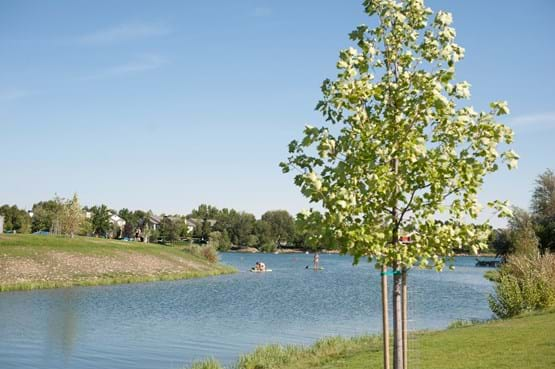Controlling Yellowjackets Around Your Home
With their potent sting, yellowjackets can be menacing creatures — especially when it comes to a showdown over the picnic table. In years when the spring is warm and dry, yellowjacket populations can increase to the point of making outdoor activities difficult. But, few people are aware that yellowjackets are beneficial as voracious predators of insect pests such as caterpillars and flies.
Due to allergies great caution should be used in dealing with any stinging insect, some people have died from being stung. Because of the danger of multiple stings, we recommend calling your local vector control district, county extension educator, or a private company for information and assistance.

Identification and Detection
Yellowjackets are a type of wasp that are often mistaken for bees. Sometimes they are confused with other less aggressive predatory wasps, especially paper wasps. Yellowjackets are relatively short and stout compared to paper wasps. Paper wasps have longer more slender bodies and long dangling legs. Some yellowjacket nests are spherical and are enclosed in a papery envelope with a small entrance hole at the bottom. Paper wasp nests are usually suspended from eaves or porch ceilings and look like tiny umbrellas filled with hexagonal cells. Hornet nests are usually the large paper nests that are observed 20 to 30 feet in the air in established larger trees. Hornets are usually black with green or yellow on their heads and are similar to yellowjackets in many senses but are predators of yellowjacket populations. Hornets also defend their nests with a very aggressive response to threats.
Less-Toxic Controls
There are several, less-toxic ways you can mitigate yellowjackets in your home and in your yard.
Removing a Yellowjacket from Inside Your House
If you are not hypersensitive to yellowjacket stings:
- Don’t aggravate the yellowjacket by swatting at it, they react very defensively to swift movements
- Wait until it lands on a flat surface
- Place a glass or plastic container over the insect and slide a stiff piece of paper under the opening of the container
- Seal the container and place it in the freezer overnight to kill the yellowjacket or take it outside and release the insect
Small numbers of yellow jackets may be removed by physical controls such as a fly swatter used when they have landed or even a vacuum cleaner to remove the occasional dwelling invader.
If you are finding many yellowjackets inside or routinely finding small numbers of them, you may have a hole in a screen or a nest in a wall void.
Destroying Nests
Yellowjackets are best managed by removing the nesting site. A nesting site can be found by following the yellowjackets back to their nests. Once the location of the nest is known control options can be considered.
Yellowjackets build nests in abandoned rodent burrows and other holes in the ground, in attics, in wall voids, under slab poured steps and in shrubs and trees. Sometimes they hang their nests from eaves.
If these nests are in high traffic areas they should be managed to prevent stings to individuals that frequent the area.

Trapping Yellowjackets
Traps can provide temporary relief from yellowjackets; however individual yellowjackets can sometimes escape traps. There are a number of traps on the market, some disposable and others reusable. Experiment to find the trap or traps that work best for you.
Chemical Controls
As a last resort in years when yellowjacket populations are extremely high, chemical control may be necessary. If you hire a professional applicator you can check an applicator’s license status on the Idaho State Department of Agriculture’s web page listed below or call 208-332-8600 and ask for license verification.
To keep this information available in your home, you can download a full PDF.